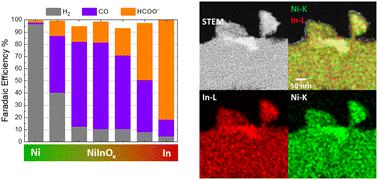当前位置:
X-MOL 学术
›
J. Mater. Chem. A
›
论文详情
Our official English website, www.x-mol.net, welcomes your feedback! (Note: you will need to create a separate account there.)
CO2 electroreduction activity and dynamic structural evolution of in situ reduced nickel-indium mixed oxides
Journal of Materials Chemistry A ( IF 11.9 ) Pub Date : 2022-09-05 , DOI: 10.1039/d2ta05214h Laura C. Pardo Pérez 1 , Zora Chalkley 1, 2 , Robert Wendt 3 , Ibbi Y. Ahmet 3 , Markus Wollgarten 3 , Matthew T. Mayer 1
Journal of Materials Chemistry A ( IF 11.9 ) Pub Date : 2022-09-05 , DOI: 10.1039/d2ta05214h Laura C. Pardo Pérez 1 , Zora Chalkley 1, 2 , Robert Wendt 3 , Ibbi Y. Ahmet 3 , Markus Wollgarten 3 , Matthew T. Mayer 1
Affiliation

|
In the field of CO2 electroreduction (CO2ER), tuning the selectivity among diverse products remains a major challenge. Mixed metal catalysts offer possible synergetic effects which can be exploited for tuning product selectivity. We present a simple wet chemical approach to synthesize a range of nickel-indium mixed oxide (NiAInBOx) thin films with homogeneous metal distribution. CO2 electroreduction results indicate that the NiAInBOx mixed oxide thin films can achieve high CO selectivity (>70%) in contrast with the single metal oxides NiO (H2 >90%) and In2O3 (formate >80%). The relative composition Ni40In60Ox attained the best CO selectivity of 71% at moderate cathodic bias of −0.8 VRHE, while a higher cathodic bias (E < −0.9 V) promoted a decrease of CO in favor of formate. A detailed investigation of the Ni40In60Ox thin films following progressive stages of reduction during CO2ER revealed dynamic structural transformations strongly dependent on applied bias and electrolysis time. For the CO-selective catalyst composition, at moderate cathodic bias (E < −0.8 V) and short electrolysis times (1 h), the catalyst is composed of nickel-indium alloy grains embedded in amorphous Ni–In mixed oxide as observed by electron microscopy. Extending electrolysis time at −0.8 V for 10 h, or increasing the applied reductive bias to −1.0 V, result in a complete reduction of the residual oxide film into an interconnected array of multicomponent (In, Ni, Ni3In7) nanoparticles which display significantly lower CO selectivity (<50%). Our results indicate that the persistent amorphous NiInOx oxide/alloy composite material preserved in the early stages of reduction at −0.8 V plays a key role in CO selectivity. The highly dynamic structure observed in this catalytic system demonstrates the importance of conducting detailed structural characterization at various applied potentials to understand the impact of structural changes on the observed CO2ER selectivity trends; and thus be able to distinguish structural effects from mechanistic effects triggered by increasing the reductive bias.
中文翻译:

原位还原镍铟混合氧化物的CO2电还原活性和动态结构演化
在 CO 2电还原 (CO 2 ER) 领域,调整不同产品的选择性仍然是一项重大挑战。混合金属催化剂提供可能的协同效应,可用于调整产物选择性。我们提出了一种简单的湿化学方法来合成一系列具有均匀金属分布的镍铟混合氧化物 (Ni A In B Ox) 薄膜。CO 2电还原结果表明,与单一金属氧化物NiO(H 2 >90%)和In 2 O 3相比,Ni A In B Ox 混合氧化物薄膜可以实现较高的CO选择性(>70%)。(甲酸盐 >80%)。相对组成 Ni 40 In 60 Ox 在 -0.8 V RHE的中等阴极偏压下获得了 71% 的最佳 CO 选择性,而较高的阴极偏压 ( E < -0.9 V) 促进了 CO 的减少,有利于甲酸盐。在 CO 2 ER 期间逐步还原阶段之后对 Ni 40 In 60 Ox 薄膜的详细研究揭示了动态结构转变强烈依赖于施加的偏压和电解时间。对于 CO 选择性催化剂组合物,在中等阴极偏压 ( E< -0.8 V) 和短电解时间 (1 h),通过电子显微镜观察,催化剂由嵌入非晶态 Ni-In 混合氧化物中的镍铟合金晶粒组成。在 -0.8 V 下延长电解时间 10 小时,或将施加的还原偏压增加到 -1.0 V,导致残留氧化膜完全还原为多组分(In、Ni、Ni 3 In 7) 显示出显着较低的 CO 选择性 (<50%) 的纳米颗粒。我们的结果表明,在 -0.8 V 还原的早期阶段保存的持久无定形 NiInOx 氧化物/合金复合材料在 CO 选择性中起关键作用。在该催化系统中观察到的高度动态结构证明了在各种应用电位下进行详细结构表征以了解结构变化对观察到的 CO 2 ER 选择性趋势的影响的重要性;因此能够区分结构效应和由增加还原偏差引发的机械效应。
更新日期:2022-09-09
中文翻译:

原位还原镍铟混合氧化物的CO2电还原活性和动态结构演化
在 CO 2电还原 (CO 2 ER) 领域,调整不同产品的选择性仍然是一项重大挑战。混合金属催化剂提供可能的协同效应,可用于调整产物选择性。我们提出了一种简单的湿化学方法来合成一系列具有均匀金属分布的镍铟混合氧化物 (Ni A In B Ox) 薄膜。CO 2电还原结果表明,与单一金属氧化物NiO(H 2 >90%)和In 2 O 3相比,Ni A In B Ox 混合氧化物薄膜可以实现较高的CO选择性(>70%)。(甲酸盐 >80%)。相对组成 Ni 40 In 60 Ox 在 -0.8 V RHE的中等阴极偏压下获得了 71% 的最佳 CO 选择性,而较高的阴极偏压 ( E < -0.9 V) 促进了 CO 的减少,有利于甲酸盐。在 CO 2 ER 期间逐步还原阶段之后对 Ni 40 In 60 Ox 薄膜的详细研究揭示了动态结构转变强烈依赖于施加的偏压和电解时间。对于 CO 选择性催化剂组合物,在中等阴极偏压 ( E< -0.8 V) 和短电解时间 (1 h),通过电子显微镜观察,催化剂由嵌入非晶态 Ni-In 混合氧化物中的镍铟合金晶粒组成。在 -0.8 V 下延长电解时间 10 小时,或将施加的还原偏压增加到 -1.0 V,导致残留氧化膜完全还原为多组分(In、Ni、Ni 3 In 7) 显示出显着较低的 CO 选择性 (<50%) 的纳米颗粒。我们的结果表明,在 -0.8 V 还原的早期阶段保存的持久无定形 NiInOx 氧化物/合金复合材料在 CO 选择性中起关键作用。在该催化系统中观察到的高度动态结构证明了在各种应用电位下进行详细结构表征以了解结构变化对观察到的 CO 2 ER 选择性趋势的影响的重要性;因此能够区分结构效应和由增加还原偏差引发的机械效应。


























 京公网安备 11010802027423号
京公网安备 11010802027423号